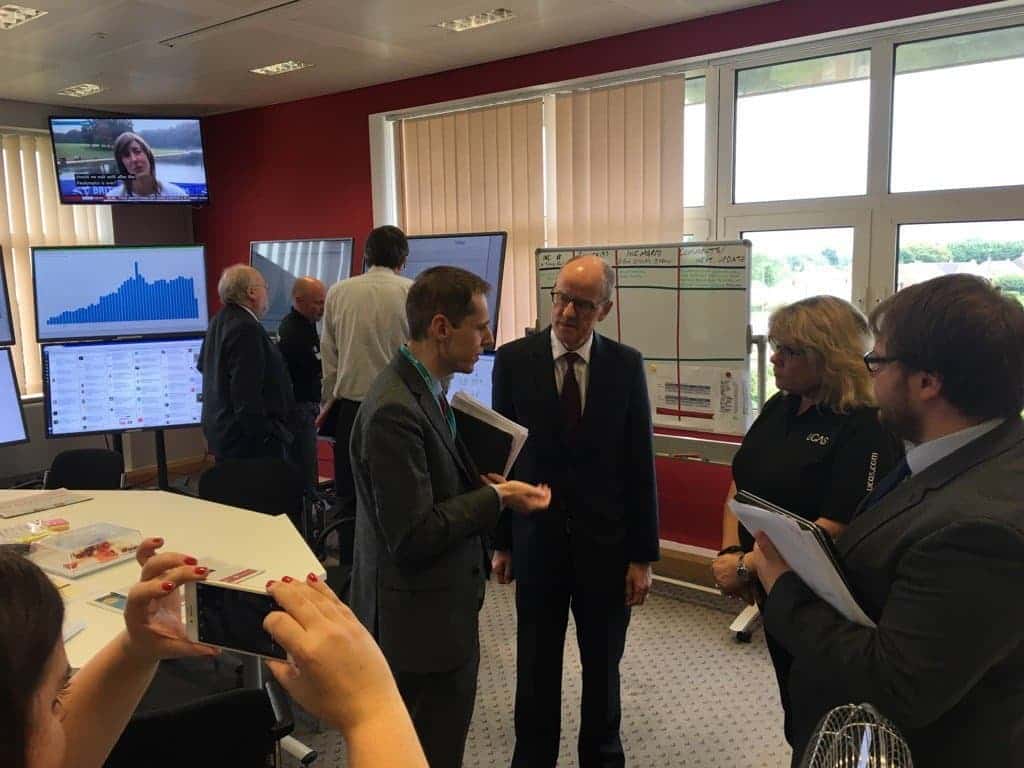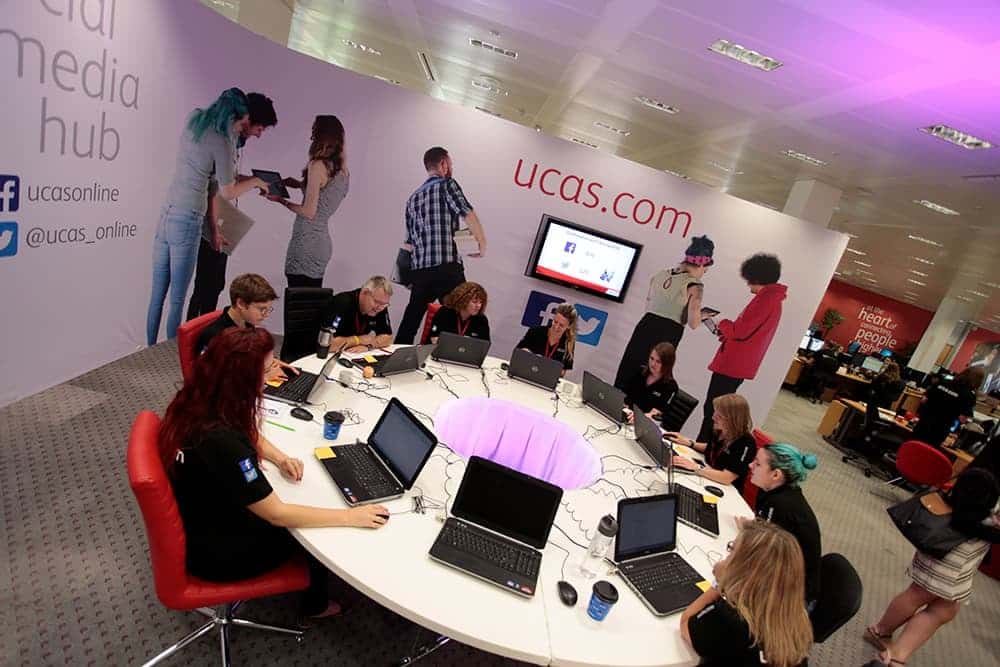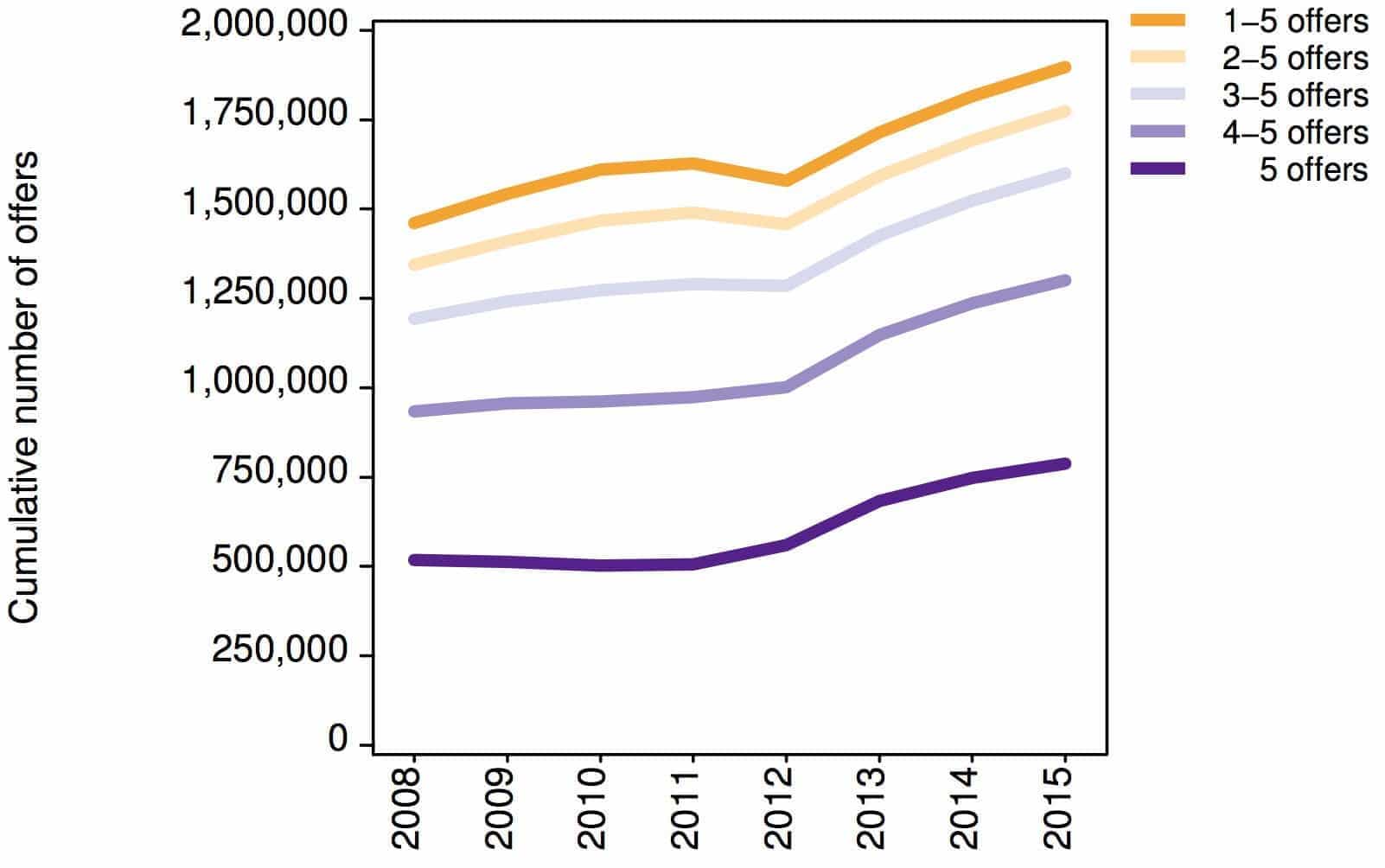Perhaps only Santa Claus has to deal with such a lopsided pattern in customer service demand. It’s A Level results day, and on my arrival at UCAS HQ at 8am, the call-centre turned TV studio is alive with activity for perhaps the busiest day of the year in the higher education calendar.
For just one day, the vast majority of the UK (or rather, English, Welsh and Northern Irish) media turns its gaze towards higher education. The silly season and dearth of political news during mid-August makes the day’s events a reliable content filler for breakfast TV and newspapers, and even the latest GB medal rush at the Olympics can’t shake the emotional envelope-opening ritual from our screens.
UCAS staff are well decked out in their branded t-shirts for the cameras, taking calls and answering social media queries. Reporters do their back and forth live-to-camera bit, Mary Curnock Cook, chief executive of UCAS, is busy going through interviews, reassuring applicants about the breadth of their options and running us through the headline statistics. Helen Thorne, Director of External Relations, is tasked with the regional news outlets, quickly getting together the statistics for every area of the UK.
A level results day is now a national media ‘happening’, but that reflects the scale and significance of the operation that UCAS is tasked with overseeing. Despite the volume of customer service and media activity, everybody I see and talk to is calm and relaxed by how well the day is going. Schools minister Nick Gibb MP and UCAS chair Professor Sir Steve Smith appear contented with the operation as they are taken on their guided tours.
Making it happen
It is hard to understate the scale of the operation that UCAS is managing today and the spike in data that is effectively being transported in and out of their headquarters facility in Cheltenham. With GCHQ’s mammoth ‘donut’ base of operations also just down the road, the town is becoming synonymous with Big Data.
The number of UCAS’s customers and stakeholders is massive: 700,000 applicants, their parents, their schools and colleges, their awarding bodies, and nearly 400 higher education providers.
UCAS receives roughly 10% of its entire annual customer relations volume on just this single day. Exactly one week before, over 12 million separate exam results have to be processed and entered into the system and sent to higher education providers in order to determine which applicants have been successful. This would be a large logistical and operational challenge in and of itself, and it is only compounded by the short time frame in which everything needs to be turned around.
I am told that, aside from Santa Claus, the only other comparable events in customer demand and service usage might be ticket sales for popular events (e.g. Glastonbury), or the voter registration deadline before the EU referendum. Readers may well remember what happened in the latter: it showed what happens when a system is not prepared for such a surge in activity.
Thankfully, from UCAS’s point of view, the surge is expected. In fact, website and customer inquiry traffic today appears to be mirroring last year almost exactly. Over the years, a great amount of work has gone into making the whole process more resilient. Disaster drills are run a few weeks in advance, including a hacking and an on-site anthrax scare. More systems have been moved to cloud centres off-site. There are backup water tanks and power generators on site to keep the building running in almost any situation, and failing that, there’s a backup centre in Bristol to move to. This isn’t over-preparation – flooding in Cheltenham in 2007 caused serious difficulties, including contaminating water in the building.

Nick Gibb MP is shown the Joint Operations Centre
All systems are monitored in the Joint Operations Centre, where leaders from across the organisation link up with the IT boffins. Ten large flatscreens act like a giant heart monitor, showing online traffic of UCAS.co.uk and UCAS track, as well as levels of service usage from different higher education providers and the overall capacity usage of the systems. Staff run through a checklist every hour and monitor developments. UCAS’s service partners, including Amazon Web Services, Microsoft, and Infosys, are all on site just-in-case. A senior executive from Infosys has come all the way from Bangalore to be on call.
All this underlines what a critical piece of national infrastructure the results day service has become – it simply cannot break. When it does, as in 2011, the vast number of students, parents and providers affected is enough to cause serious public anxiety and panic.
The applicant journey
By 8am there have been 206,000 logins into UCAS Track as applicants desperately check whether they have been successful or not. At 8am exactly there is a peak of 276 logins per second. By 4.30pm there have been nearly 1.2 million logins and nearly 12,000 customer queries on the phones.
The pattern of traffic for the day is almost identical to last year. The first spike comes around 8am when Track announces whether applicants have been successful getting into their firm or insurance choices. Things quieten down a little for staff on the phones after 9am, as applicants all head into their schools and colleges to find out their full results. By 11am, once most students have received their full results, the phones are once again buzzing as queries flood in about Clearing, Adjustment and near misses. Over 200 are staffing the phones here in Cheltenham and at an outsourced site in Liverpool, and a team of social media experts are responding to the ever-increasing number of queries across Facebook and Twitter.

UCAS staff respond to applicant queries on social media
Listening in on the calls reminds you how behind all these numbers are human stories and mini-dramas of hope, expectation, disappointment and delight. The sheer variety of queries is instructive. On the more mundane end, we have applicants who have forgotten their login details or are struggling to make a debit card payment. On the other hand, callers have to deal with applicants who can’t quite believe they’ve ‘got in’ and just want to make sure. Then there are those who are distraught at having missed out. Some are having second thoughts about their initial choices and don’t know whether to jump into the Clearing pool. Others what to clarify rumours or hearsay about what will improve their chances. There are also many queries from parents and teachers. The staff on the phones find themselves dealing with a whole range of emotions: they are consoling and congratulating in equal measure.
For those who need more comprehensive advice, there is a separate room of specialist careers advisors, a joint project with DfE. Over 10,000 calls are made to this pop-up centre, which is staffed by advisors who work in schools, universities, colleges and other professional advice services. It will be there until August 31st.
Responding to a changing admissions environment
While the customer-facing side of UCAS is working to support applicants and institutions, the analysis team are crunching the numbers to satisfy the press demands and the interest of admissions wonks. Some analysts have been there since midnight preparing the press notes in time for the morning.
The last few years’ numbers are showing some important trends in admissions practice as both applicants and institutions react to the changing market and to the uncapping of student numbers. This, in turn, is accentuating the operational challenges that UCAS face in trying to make an increasingly unstable and volatile system run smoothly.
The critical change over the last few years is that the vast majority of universities are no longer in a process of selecting; they are in a process of recruiting. Very few institutions have been able to both increase their average tariff and increase student numbers. The price of expansion for most institutions is a lowering of the entry threshold.
The vast majority of institutions have increased their offer rate (i.e. the percentage of applicants given offers) significantly over the past few years. This effect doubles down on itself. The more that some institutions increase the number of offers made, the more that competitor institutions have to follow, as there is a greater chance that their existing offers might not convert. Even then, the greater difficulty in converting offers into confirmed places while there is greater pressure to ensure that spaces are filled has led to more places becoming available in Clearing.
From the student side, there is a significantly greater amount of choice after application as much as there is before applying. The number of applicants getting five offers for different universities has increased substantially, while fewer applicants are getting no offers at all.
Total number of offers made to all main scheme applicants by number of offers received (cumulative categories)

Source: UCAS End of Cycle Report 2015
There has also been substantial growth in places available through Clearing. Last year, one in every eight entrants to higher education went through Clearing, an increase of 25% since 2011. Crucially, an increasing number of students who had not originally applied to enter higher education are choosing to do so after A level results day. 15,000 new applicants entered the UCAS system through Clearing who hadn’t applied at all before getting their results.
This fierce competition and ‘buyers market’ has received much media attention this year, with coverage focusing on buy one get one free deals, free iPads and tickets to see football matches, all on offer. But there is very little evidence at present that any of this works. Away from media scrutiny, the vast majority of institutions are investing their time in connecting with applicants and making the best impression that they can, to have the greatest chance of converting an offer into an accepted place.
The applicants with the most choices on offer are the highest performing students; those with ABB+ or equivalent at A level. Their numbers are decreasing both in absolute and relative terms. Government reforms have halted the continuing improvement in A level grades, and the overall number of eighteen-year-olds is declining. High tariff institutions are having to fight harder than ever to win over these students, as each one accepted is a boost to the average tariff figure that is such an important input to league tables.
For universities across the entry-level tariff spectrum, it is now more vital than ever to understand the small group of direct competitors who might be poaching their applicants. These are typically institutions with similar tariff levels in similar towns and cities, and with student bodies of a similar social makeup. Many admissions departments are investing in specialised analytical programmes that can help them better understand their applicants’ possible other options (i.e. their competitors) and their likelihood of converting into an accepted place.
The churn will continue as long as demand for places remains high, but there are signs that the overall market is beginning to flatline. The international market has taken a severe hit over the past couple of years, and the demographic dip in potential home applicants will hurt the most reliable recruitment area for most universities. Surprisingly, this years’ numbers suggest that the EU market may not be as badly hit by Brexit as some were expecting. EU acceptances have grown again despite the referendum result.
The coalface of the new higher education market
Being in UCAS HQ on results day brings the market volatility to life as the competition across universities is played out visibly through continually moving numbers and charts. UCAS’s challenge is to bring some cohesion to this increasingly chaotic and confusing arena, both for institutions and applicants. One can only imagine the chaos that would reign in an uncapped market if UK higher education did not have a centralised admissions service.
UCAS’s job will only become more important as the government presses ahead with liberalising market forces. New proposals for credit-transfer and allowing for ‘market exit’ will require more agile connections between institutions and applicants. The introduction of a new wave of small private providers will require an increasingly diverse range of institutions to coordinate their admissions work to improve applicants’ experiences.
Cumulatively this all leaves UCAS under greater scrutiny from government, universities and the media. Recent rows over data transparency and admissions have perhaps given us a taste of what’s to come. The introduction of a more volatile market system with uncapped numbers has overturned many long-held assumptions about ‘fairness’ and ‘selectivity’ in university admissions and increased the scope for debate about how the system should operate.
The uncapping of student numbers has done all this far more effectively than the introduction of £9,000 fees and had a far more profound effect on UCAS, universities and the students I could hear at the other end of the phone on results day.













